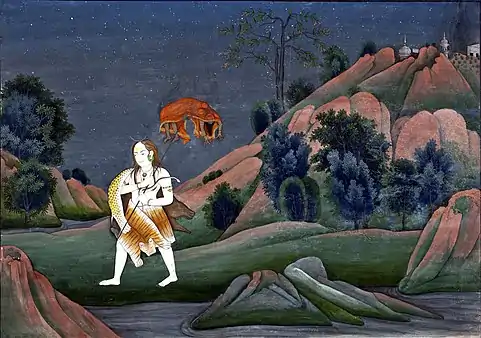Nartiang Durga Temple
Nartiang Durga Temple is a 600-year-old Durga Temple located in the West Jaintia Hills district of Meghalaya, a state in North-Eastern India.[1] This temple is one of the 51 Shakti Peethas and is one of the holiest sites for devotees of the Shaktism sect of Hinduism.[2] The tribal Hindus in the Jaintia Hills of Meghalaya believes that this temple is the permanent abode of Goddess Durga.The temple draws a large number of pilgrims from all over the country on occasion of Durga Puja.[1] The Shakti of Nartiang Devi shrine is worshipped as Jayanti and the Bhairava as Kamadishwar.[3]

Significance

The Nartiang Devi Temple is believed to be a Shakti Peetha, one of the most revered shrines of Shaktism as Shakti Peethas are Holy abodes of Parashakti. The Shakti Peethas have originated from the mythology of Daksha yagna and Sati's self immolation Shiva carried the corpse of Sati Devi and 51 body parts of the corpse fell in the path He had wandered. Each temple has shrines for both Shakti as well as the corresponding male energy counterpart Kalabhairava. The "Shakti" of Nartiang Devi shrine is addressed as 'Jayanti' and the "Kalabhairava" as 'Kamadishwar'. It is believed that Sati Devi's left thigh had fallen here.[2]
History
Devi's left thigh is believed to have fallen at Nartiang in the Jaintia Hills. Hence the Goddess here is known as Jainteshwari. The Jaintia king Jaso Manik (1606–1641) had married Lakshmi Narayana, the daughter of the Hindu Koch king Nara Narayana. It is believed that it was Lakshmi Narayana who had influenced the Jaintia Royalty to embrace Hinduism. King Dhan Manik had made Nartiang the summer capital of the Jaintia Kingdom about 600 years ago. One night, the goddess appeared to him in a dream and informed him of the significance of the place and asked him to build a temple in Her honour. Following this, the Jainteshwari temple in Nartiang was established. The strategic location of the temple and presence of weapons like cannons suggests that the temple must have been part of a fort of the Jaintia Kings.
Worship
The rites at the temple are not performed the conventional way as in the plains, but in a unique way, a blend of Hindu and ancient Khasi traditions. The local chieftain or Syiem is considered the chief patron of the temple. Even today, during Durga Puja, the Syiem sacrifices goats. Durga Puja is the most important festival of this temple. During Durga Puja, a banana plant is dressed up and worshipped as the Goddess. At the end of the four-day festivities, the plant is ceremoniously immersed in the Myntdu River. A gun salute is also given to the Goddess on the occasion.
At present
The Central Puja Committee, the official representative of the Hindu community in Meghalaya, is the caretaker of the temple. It finances a major part of the daily expenses incurred by the temple and carries out development activities in the temple premises. It is also responsible for the popularisation of the Durga Puja conducted in this ancient temple.Here Durga puja is done every autumn in a unique way with the fusion of the culture of Bengal and that of the Khasi-Jaintia Hills. In conformity of the Khasi custom of not using figurine images of Gods and Goddesses, the image of Durga is represented by a plantain trunk decked with marigold flowers. Close by, within walking distance, is the Shiva temple where one can see the remains of ancient cannons from the past inside the temple. At present there lies a Hindu temple in this vicinity and the priests who practice there are direct descendants of the original priests that came from Jaintiapur.
In 2017 ,the union minister Kiren Rijiju said that the temple will be declared as a heritage site[4]
How to reach there
The temple in village Nartiang in Jaintia Hills district is at a distance of 50 km from Shillong. It is better to go by car. There is a rest house near the temple [5]
References
- Das, Manosh (15 October 2010). "Lofty Himalayas notwithstanding, the tribal people of Nartiang in the Jaintia Hills of Meghalaya truly believe that their scenic little hamlet is the "permanent abode" of Goddess Durga. Perched atop a hillock is the more than 600-year old and ancient Durgabari - a simple house made of stones and wood complete with tin roofing. Revered as one of the 51 Shakti Peethas, the temple has been drawing a large number of pilgrims from all over the country on occasion of Durga Puja". The Times of India. Retrieved 5 March 2020.
- "Jayanti Shakti Pith, Meghalaya". ambaji.org. Retrieved 5 November 2017.
- http://m.timesofindia.com/articleshow/40349414.cms
- https://www.indiatoday.in/pti-feed/story/500-yr-old-durga-temple-to-be-declared-heritage-site-rijiju-1055577-2017-09-30
- The Sacred Journey, N K Prasad and Smt Shivrani Prasad